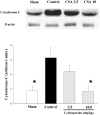Cyclosporine treatment reduces oxygen free radical generation and oxidative stress in the brain of hypoxia-reoxygenated newborn piglets
- PMID: 22792343
- PMCID: PMC3392221
- DOI: 10.1371/journal.pone.0040471
Cyclosporine treatment reduces oxygen free radical generation and oxidative stress in the brain of hypoxia-reoxygenated newborn piglets
Abstract
Oxygen free radicals have been implicated in the pathogenesis of hypoxic-ischemic encephalopathy. It has previously been shown in traumatic brain injury animal models that treatment with cyclosporine reduces brain injury. However, the potential neuroprotective effect of cyclosporine in asphyxiated neonates has yet to be fully studied. Using an acute newborn swine model of hypoxia-reoxygenation, we evaluated the effects of cyclosporine on the brain, focusing on hydrogen peroxide (H(2)O(2)) production and markers of oxidative stress. Piglets (1-4 d, 1.4-2.5 kg) were block-randomized into three hypoxia-reoxygenation experimental groups (2 h hypoxia followed by 4 h reoxygenation) (n = 8/group). At 5 min after reoxygenation, piglets were given either i.v. saline (placebo, controls) or cyclosporine (2.5 or 10 mg/kg i.v. bolus) in a blinded-randomized fashion. An additional sham-operated group (n = 4) underwent no hypoxia-reoxygenation. Systemic hemodynamics, carotid arterial blood flow (transit-time ultrasonic probe), cerebral cortical H(2)O(2) production (electrochemical sensor), cerebral tissue glutathione (ELISA) and cytosolic cytochrome-c (western blot) levels were examined. Hypoxic piglets had cardiogenic shock (cardiac output 40-48% of baseline), hypotension (mean arterial pressure 27-31 mmHg) and acidosis (pH 7.04) at the end of 2 h of hypoxia. Post-resuscitation cyclosporine treatment, particularly the higher dose (10 mg/kg), significantly attenuated the increase in cortical H(2)O(2) concentration during reoxygenation, and was associated with lower cerebral oxidized glutathione levels. Furthermore, cyclosporine treatment significantly attenuated the increase in cortical cytochrome-c and lactate levels. Carotid blood arterial flow was similar among groups during reoxygenation. Conclusively, post-resuscitation administration of cyclosporine significantly attenuates H(2)O(2) production and minimizes oxidative stress in newborn piglets following hypoxia-reoxygenation.
Conflict of interest statement
Figures





References
-
- Vannucci RC. Hypoxic-ischemic encephalopathy. Am J Perinatol. 2000;17:113–120. - PubMed
-
- Jacobs SE, Tarnow-Mordi WO. Therapeutic hypothermia for newborn infants with hypoxic-ischemic encephalopathy. J Paediatr Child Health. 2010;46:568–576. - PubMed
-
- Vannucci RC. Current and potentially new management strategies for perinatal hypoxic-ischemic encephalopathy. Pediatrics. 1990;85:961–968. - PubMed
-
- Rodrigo J, Fernandez AP, Serrano J, Peinado MA, Martinez A. The role of free radicals in cerebral hypoxia and ischemia. Free Radical Biol Med. 2005;39:26–50. - PubMed
Publication types
MeSH terms
Substances
Grants and funding
LinkOut - more resources
Full Text Sources
Other Literature Sources

